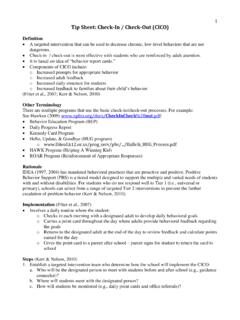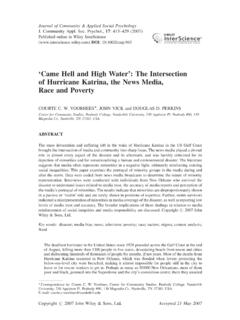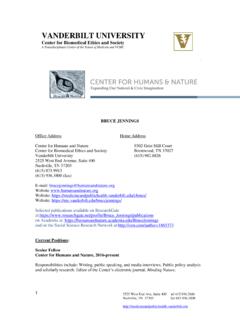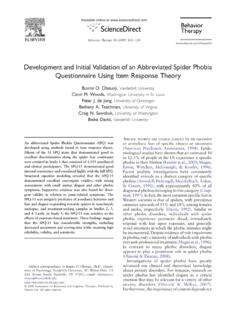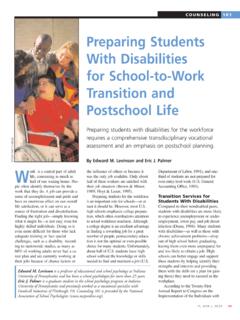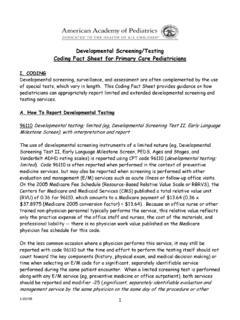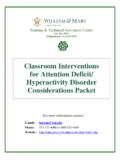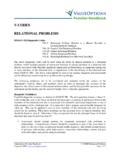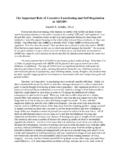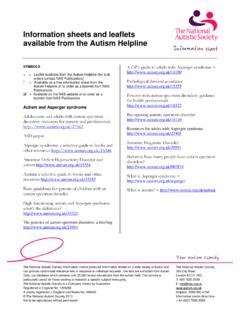Transcription of Tip Sheet: Functional Behavior Assessment and Function ...
1 1 Tip sheet : Functional Behavior Assessment and Function -Based interventions Definition Functional Behavior Assessment (FBA) is a process of gathering information from a variety of sources to develop a hypothesis regarding why a student is displaying challenging behaviors. The Function is assessed in terms of a student s context/environment. This means determining what happens before the problem Behavior occurs ( , antecedents that can lead to or exacerbate the problem Behavior ) and what happens after the problem Behavior occurs (consequences that can maintain the Behavior ). Maintaining consequences are either positive reinforcement (student misbehaves to get something such as attention , object, activity, event, sensory stimulation) or negative reinforcement (student misbehaves to escape/avoid something such as attention , object, activity, event, pain or discomfort).
2 Once a hypothesis has been developed as to why the Behavior occurs, a Behavior intervention plan is designed based on the maintaining Function to decrease the challenging Behavior and increase positive, prosocial Behavior (Alberto & Troutman, 2009; Scott et al., 2008) Other Terminology Functional Behavior Analysis or Functional Analysis of Behavior (FAB) Rationale (Kerr & Nelson, 2010) interventions are more successful that are designed to address both the form and Function of the problem Behavior than interventions that are designed simply to reduce inappropriate Behavior . Instead of focusing on just the definition of a Behavior , focus on why a Behavior is occurring. Possible Function of Behavior : To get access to something o Social attention (teacher, parent, peer) o Tangible (object, activity, event) o Sensory stimulation ( , visual, kinesthetic) To escape or avoid something o Social interaction or attention (teacher, peer) o Tangible (object, activity, event) o Demanding task o Internal pain or discomfort The benefits include: o Improved behavioral outcomes with a hypothesis-driven intervention; o Increased appropriate, prosocial behaviors with reduced emphasis on punishment; o Increased likelihood of meaningful and lasting change (Alberto & Troutman, 2003; Ingram et al.)
3 , 2005; Stahr et al., 2006). Implementation: Steps in Functional Behavior Assessment and Function -Based interventions (The IRIS Center, 2009). See below for more information on each section. Note: Although the use of FBA with student with challenging Behavior is mandated by federal law, currently there is not a research or federally accepted standardized protocol (Scott et al., 2004). 2 Determine the Behavior 's Function Step 1: Identify and define problem and replacement behaviors Step 2: Collect data Step 3: Identify the Function of the Behavior (gain/get or escape/avoid) Develop and Implement a Function -Based Intervention Step 4: Design a Function -based intervention Step 5: Maximize intervention success Step 6: Implement the intervention Evaluate the Effectiveness of the Intervention Step 7: Evaluate the intervention Below are the steps with more detailed information.
4 See FBA PowerPoint for an example. Determine the Behavior 's Function Step 1: Identify and define problem and replacement behaviors o Clear, concise, measurable definitions with examples and nonexamples. See below for example: Non-engagement is any time Mark is not attending to classroom instruction or completing assigned work assigned. Examples: Making verbal and non-verbal noises without permission; out of sear without permission; talking or gesturing to other students which is unrelated to the assignment Non-examples: Looking at teachers during instruction; raising hand to make a statement or request assistance; or working on an assignment during class. Academic Engagement is the amount of time Mark spends actively engaged & working on relevant assignments or activities in academic settings.
5 Examples: Looking at the teacher while she was instructing; working on the assigned tasks; requesting assistance in an acceptable manner; and following directions. Non-examples: Not attending to the assigned task; displaying disruptive behaviors; and breaking classroom rules Step 2: Collect data (remember to use a variety of both direct and indirect data sources) o Record review - Look for: Academic performance Could target behaviors be related to an academic skill deficit ? History of disciplinary actions or previous interventions What has or has not worked? What has or has not worked? Medical or health factors Other risk factors o Teacher, parent, student interviews Look for: 3 WHO is present when the student exhibits target Behavior ?
6 WHAT happens right before the target Behavior (antecedent) and what happens right after the target Behavior (consequence)? WHEN does a Behavior occur (time of day; Specific activity)? WHERE does a Behavior occur? Also, remember to identify when/where/with whom a target does not occur! Example of interview form: The Functional Assessment Interview (O Neill et al., 1997) o Rating scales Designed to provide information related to Function of the target Behavior Function . Respondents answer questions about the frequency of behaviors. Numerical scores rank order the possible functions A few options .. Problem Behavior Questionnaire (PBQ; Lewis et al., 1994). Motivational Assessment Scale (MAS; Durand & Crimmins, 1988) The Functional Assessment Analysis Screening Tool (FAST: Iwata & DeLeon, 1996) The Questions about Behavioral Function (QABF; Paclawskyj et al.)
7 , 2000) o Direct Observation Scatter Plot (Touchette et al., 1985) Use a grid to determine estimated frequency and patterns of target Behavior across setting and time A-B-C Detailed recording of the antecedents that occur before the target Behavior and the consequences that occur after the target Behavior Baseline Data Collect data on the target and replacement behaviors using frequency, interval, duration, or latency Step 3: Identify the Function of the Behavior (gain/get or escape/avoid) o Why is the student behaving this way? o All behaviors occur to GET (access) or GET OUT OF (avoid) something: attention (peers or teacher) Activities Tangibles Sensory o When determining the Function of the Behavior , examine the consequence that resulted from the Behavior o Summarize all data sources using the Function Matrix (See below; Umbreit et al.
8 , 2007) o Develop a hypothesis Example: During independent work time and when the teacher is working with other students, Steve gets out of his seat and calls out to gain teacher attention . 4 Develop and Implement a Function -Based Intervention Step 4: Design a Function -based intervention o Determine if and how the replacement Behavior needs to be taught ( can t do or won t do) o Determine antecedent adjustments to prevent problem Behavior from occurring and to prompt replacement Behavior Examples: change room arrangement; increase teacher prompts; offer choices o Determine consequence modifications Reinforce replacement Behavior Do not reinforce problem Behavior ( , ignore, use extinction) Step 5: Maximize intervention success o Determine social validity o Evaluate intervention fidelity (AKA implementation fidelity; treatment integrity.
9 See below for example) o Plan for generalization and maintenance Step 6: Implement the intervention Evaluate the Effectiveness of the Intervention Step 7: Evaluate the intervention o Compare baseline and intervention data o Monitor intervention fidelity data o Implement plans for generalization and maintenance Functional Assessment Matrix Example functions of Behavior Access/Obtain Escape/Avoid attention *Teacher interview: When Steve is out of his seat, teacher goes to his desk. *Student interview: Steve says his teacher ignores him when he needs help. *Rating scale: High rating for teacher attention . *ABC observation: Function of Behavior appears to be teacher attention . Tangibles or Activities, *Teacher interview: Off task happens mostly during independent seatwork.
10 *Parent interview: Steve tells parent that the work is too easy, and he gets bored. Sensory Conditions Adapted from Umbreit, J., Ferro, J., Liaupsin, C. J., & Lane, K. L. (2007). Functional behavioral Assessment and Function -based intervention: An effective, practical approach. Upper Saddle River, NJ: Pearson Press. Figure , page 84. 5 Treatment Integrity Checklist Example Intervention Components Mon. Tues. Wed. Thurs. Fri. Antecedent Conditions Did the teacher explain the assignments and provide examples? Did Julie choose a peer assistant to help if she had questions? Did Julie rate her accuracy and completion and then check it with a peer? Reinforcement Did Julie receive peer attention after completing each assignment?
